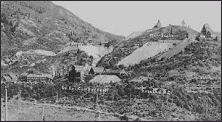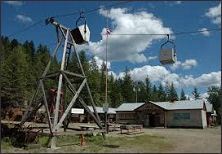Main Listing Page
Rossland's Le Roi Mine
The Le Roi Mine was first discovered by prospectors from the nearby Dewdney Trail. The Le Roi mine is what started the gold rush in Rossland in 1890. Colonel Topping bought the claims for $12.50 in a recording fee. He later sold it to a US corporation for 30,000 dollars. Later the those owners sold it to the British American Company for just over three million dollars.
Once the mine was producing, the stock jumped from fifty cents a share to $40 almost overnight. Population of Rossland sky rocketed as gold fever attracted men from around the world and Rossland became one of the largest cities in Western Canada. When a wagon road was built to Trail Creek Landing in 1893 and close to 2,000 mining properties had been staked in the area by the end of 1895, things really began booming.
The mines were worked for the next forty odd years. By 1897, the population had increased to 7,000, with over 40 saloons, 4 banks and 17 law firms. Rossland is BC's second largest gold producing camp in history, with over 3 million ounces of gold and 3.5 million ounces of silver produced between 1899 and 1928 from the Le Roi, Centre Star, Josie, War Eagle and other mines.
Soon a smelter was built in the valley below and a town was built around that smelter. That town is today the town of Trail. The mines and smelter were amalgamated in 1906 to form the company now known as Cominco.
The Le Roi deposit, part of the main vein system, consisted of a series of ore shoots with narrow width or strike length with the greatest dimension on the dip. Between 1889 and 1917, 1,791,680 tonnes of ore were mined from the Le Roi deposit from which was recovered 24,091,170 grams of gold, 37,563,105 grams silver and 21,330,618 kilograms copper.
As production declined at the mine, so did the town’s prosperity. In 1922, the railways were pulled up and before the end of the decade, the business district in Rossland was hit with two major fires. By 1930, the population had dropped to 3,000. However, with the Cominco operation at Trail, as well as the arrival of a modern highway system, Rossland seemed destined to become a residential city.
The Le Roi gold mine consisted of 130 kilometres of underground workings, and its ore averaged 0.5 ounces of gold and 0.6 ounces of silver per ton, and 1% copper. The mine shut down in 1929 and after 40 years in operation, had a combined output nearing $165 million.





